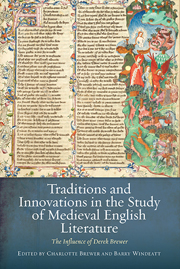 Traditions and Innovations in the Study of Medieval English Literature
Traditions and Innovations in the Study of Medieval English Literature Book contents
- Frontmatter
- Contents
- List of Contributors
- Acknowledgements
- Note on References
- Introduction: A Modern Medievalist's Career
- 1 Derek Brewer: Chaucerian Studies 1953–78
- 2 Brewer's Chaucer and the Knightly Virtues
- 3 Class Distinction and the French of England
- 4 Time in Troilus and Criseyde
- 5 Virtue, Intention and the Mind's Eye in Troilus and Criseyde
- 6 Falling in Love in the Middle Ages
- 7 The Idea of Feminine Beauty in Troilus and Criseyde, or Criseyde's Eyebrow
- 8 ‘Greater Love Hath No Man’: Friendship in Medieval English Romance
- 9 Gowerian Laughter
- 10 Derek Brewer's Romance
- 11 Malory and Late Medieval Arthurian Cycles
- 12 The Ends of Storytelling
- 13 Manuscripts, Facsimiles, Approaches to Editing
- 14 Words and Dictionaries: OED, MED and Chaucer
- 15 Afterlives: The Fabulous History of Venus
- Afterword: Derek Brewer: with ful deuout corage
- Bibliography
- Index
- Tabula in Memoriam
5 - Virtue, Intention and the Mind's Eye in Troilus and Criseyde
Published online by Cambridge University Press: 05 September 2013
- Frontmatter
- Contents
- List of Contributors
- Acknowledgements
- Note on References
- Introduction: A Modern Medievalist's Career
- 1 Derek Brewer: Chaucerian Studies 1953–78
- 2 Brewer's Chaucer and the Knightly Virtues
- 3 Class Distinction and the French of England
- 4 Time in Troilus and Criseyde
- 5 Virtue, Intention and the Mind's Eye in Troilus and Criseyde
- 6 Falling in Love in the Middle Ages
- 7 The Idea of Feminine Beauty in Troilus and Criseyde, or Criseyde's Eyebrow
- 8 ‘Greater Love Hath No Man’: Friendship in Medieval English Romance
- 9 Gowerian Laughter
- 10 Derek Brewer's Romance
- 11 Malory and Late Medieval Arthurian Cycles
- 12 The Ends of Storytelling
- 13 Manuscripts, Facsimiles, Approaches to Editing
- 14 Words and Dictionaries: OED, MED and Chaucer
- 15 Afterlives: The Fabulous History of Venus
- Afterword: Derek Brewer: with ful deuout corage
- Bibliography
- Index
- Tabula in Memoriam
Summary
Early on in Chaucer's Troilus and Criseyde, the adolescent prince Troilus, while cruising the Trojan girls at the Palladion festival in Troy, happens to see the young widow Criseyde standing in the crowd (1. 269–301). ‘His eye percede’ the crowd deeply until it ‘smote’ Criseyde and stopped (‘stente’), like an arrow (1. 272–3; cf. 1. 325). The effect on him is immediate: ‘he wax ther-with astoned … And of hire look [appearance] in him ther gan to quyken/ So gret desire … / That in his hertes botme gan to stiken/ Of hir his fixe and depe impressioun’ (1. 274, 295–8). Snail-like, he draws in his horns (1. 300), quits the scene at once, and goes home to his bed chamber, alone. This is emphasized. There he rehearses in full detail the event that had at first so ‘astoned’ him and turned him mentally to stone. He sees again Criseyde in the temple, fully and exactly as she appeared and acted:
And whan that he in chambre was allone,
He doun vp-on his beddes feet hym sette,
And first he gan to sike, and eft to grone,
And thought ay on hire so with-outen lette,
That as he sat and wook, his spirit mette
That he hire saw, and temple, and al the wise
Right of hire look, and gan it newe a-vise.
(1. 358–64)He is completely alone, sitting on his bed, groaning, and in that physical posture, undertaken deliberately like a preparatory exercise, he thinks on his experience of Criseyde with such complete concentration that his ‘spirit’ – animus, mind – sees it all again: ‘Thus gan he make a mirour of his mynde,/In which he saugh al holly hire figure’ (1. 365–6).
- Type
- Chapter
- Information
- Traditions and Innovations in the Study of Medieval English LiteratureThe Influence of Derek Brewer, pp. 73 - 87Publisher: Boydell & BrewerPrint publication year: 2013


